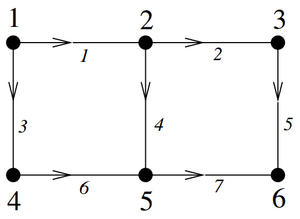Science:Math Exam Resources/Courses/MATH307/April 2013/Question Section 201 05 (c)
{{#incat:MER QGQ flag|{{#incat:MER QGH flag|{{#incat:MER QGS flag|}}}}}}
• Q1 (a) • Q1 (b) • Q1 (c) • Q1 (d) • Q2 (a) • Q2 (b) • Q2 (c) • Q2 (d) • Q2 (e) • Q2 (f) • Q3 (a) • Q3 (b) • Q3 (c) • Q4 (a) • Q4 (b) • QS201 5(a) • QS201 5(b) • QS201 5(c) • QS201 6(a) • QS201 6(b) • QS201 6(c) • QS201 6(d) • QS201 7(a) • QS201 7(b) • QS201 7(c) • QS202 5(a) • QS202 5(b) • QS202 5(c) • QS202 5(d) • QS202 6(a) • QS202 6(b) • QS202 7(a) • QS202 7(b) • QS202 7(c) • QS202 7(d) • QS202 7(e) •
Question Section 201 05 (c) |
|---|
|
Consider the following graph, interpreted as a resistor network with all resistances R = 1. (c) Suppose that by attaching a battery, the voltage at vertex 1 is held at b1 and the voltage at vertex 2 is held at b2. Write down vectors v and J so that the equation Lv = J describes this situation. Explain what each entry of v and J represents, and how you can use the entries to compute the effective resistance between vertices 1 and 2. |
|
Make sure you understand the problem fully: What is the question asking you to do? Are there specific conditions or constraints that you should take note of? How will you know if your answer is correct from your work only? Can you rephrase the question in your own words in a way that makes sense to you? |
|
If you are stuck, check the hint below. Consider it for a while. Does it give you a new idea on how to approach the problem? If so, try it! |
Hint |
|---|
|
Science:Math Exam Resources/Courses/MATH307/April 2013/Question Section 201 05 (c)/Hint 1 |
|
Checking a solution serves two purposes: helping you if, after having used the hint, you still are stuck on the problem; or if you have solved the problem and would like to check your work.
|
Solution |
|---|
|
Here every entry is the voltage at the corresponding node. b1 and b2 are the voltages held by the battery connected at nodes 1 and 2. Here every entry is the current flowing into/out of the corresponding node. c is the current coming out of node 1 from the battery, -c is the current coming out of node 2 from the battery. To find Reff remember Ohm's law: V=IR. Hence Notice that c is determined by the resistance of the rest of the circuit. If c is unknown, the effective resistance can be computed using Schur’s Complement. Remember: |
{{#incat:MER CT flag||
}}





